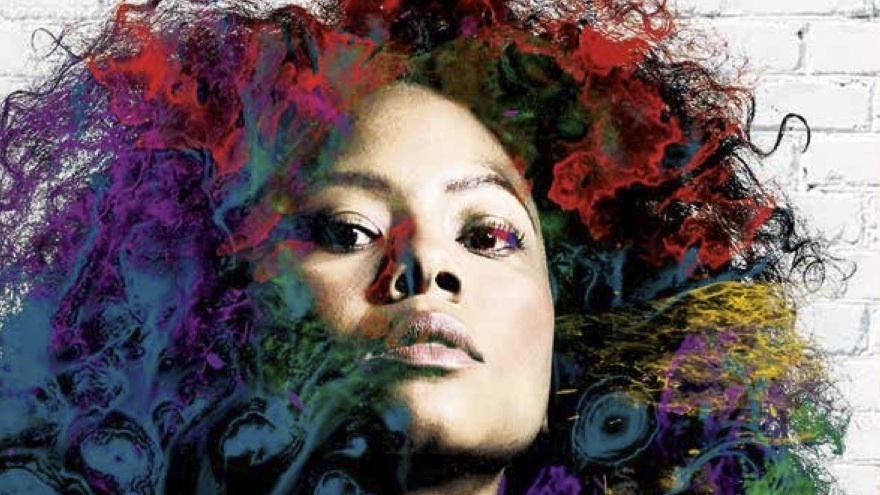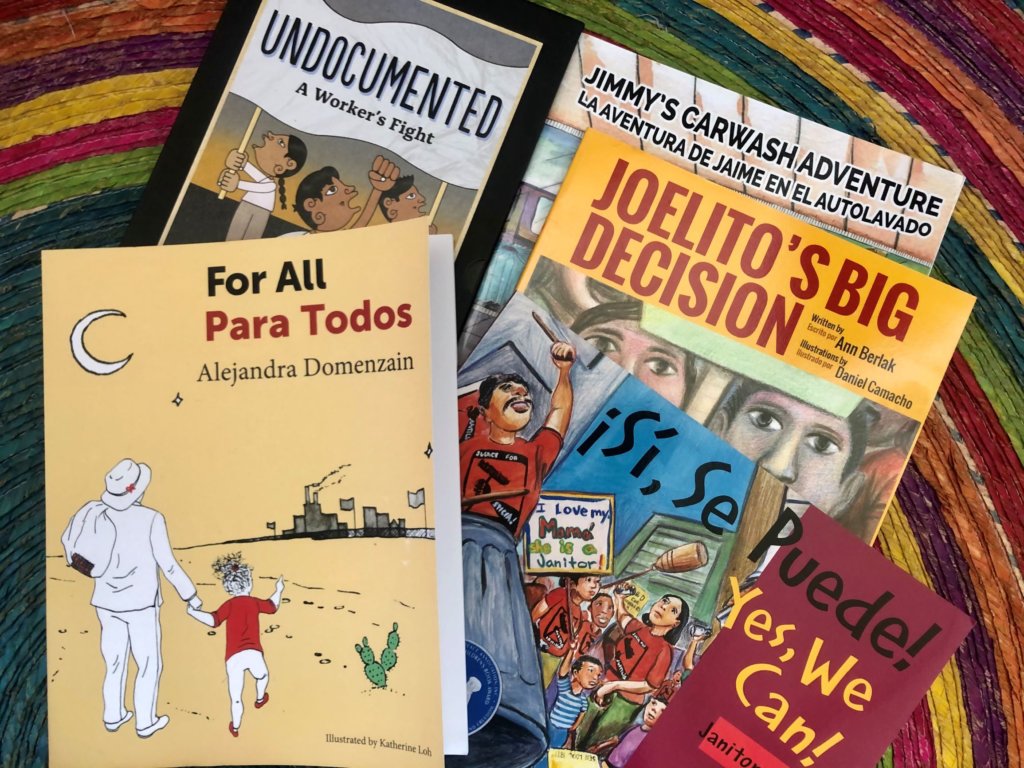Six Afro-Latino/a/x Books Young Readers Should Add to Their Collection
By UnidosUS Consultant William Garcia-Medina.
For decades, Black and Latino history have been taught as two fairly separate experiences, and that’s even evident in the way we break up commemorations of that history with Black History Month in February and Hispanic/Latinx Heritage Month from mid-September to mid-October. But in reality, Afro-Latino communities have been living and thriving in the United States for more than a hundred years. It’s time we make sure our children and youth expand their knowledge about other racialized experiences in Black and Latinx communities. This list features books about Afro-Latinos and their experiences, history, stories, and ancestral traditions.
Bad Hair Does Not Exist/¡Pelo Malo No Existe!

Bad Hair Does Not Exist/¡Pelo Malo No Existe! is a children’s picture book written by Sulma Arzu-Brown and illustrated by Isidra Sabio. Written in English and Spanish side-by-side, this book is all about addressing prevalent anti-Black notion in communities of color that hair that is kinky, or has tight curls and coils is “pelo malo” or “bad hair.” Arzu-Brown addresses this head on by teaching children that bad hair or “pelo malo” does not exist, asking children to embrace the beauty of their curls, coils, and afros. The beautiful illustrations by Isidra Sabio display a myriad of skin tones of young Black girls with various hair colors, textures, styles, and lengths. She also depicts young Black women with such hair styles and types who are ballerinas, astronauts, grandmothers, doctors, superheroes, athletes, scientists, among others.
“This book is a tool of empowerment for all little girls who are Black, Afro-descendant, Afro-Latinas, and Garifuna. Raised in a predominantly Spanish community in the Bronx, New York, I encountered a series of events in which the term “pelo malo” (meaning bad hair) was used too closely and irresponsibly to describe the natural (not chemically) hair of black girls and girls of Afro-descent without thinking about the damage it inflicts on their self-esteem,” writes Arzu-Brown in the book’s introduction.
The book’s simple language and beautiful illustrations create an opportunity for talking with children about hair and anti-Blackness.
“There are all types of hair/Hay toda clase de pelo. And all hair is good! ¡Y todo pelo es bueno!” the book reads.
The end of the book includes fun activities such as asking readers to draw their types of hair and that of their family members. For a lesson around hair and image, an educator can show students pictures of different hair styles and ask them which styles they find pretty and which ones they find ugly. After students respond, the educator could ask students to answer why they think certain types of hair are prettier than others. After that, the teacher can read Bad Hair Does Not Exist/¡Pelo Malo No Existe! and follow it with some of the activities included in it. All in all, Arzu-Brown’s book emphasizes the human experiences in diverse ways that highlight sharing and showing gratitude towards one another. There is no such thing as bad hair. All styles of hair should be embraced by everyone.
Roberto Clemente: Pride of the Pittsburgh Pirates

Roberto Clemente: Pride of the Pittsburgh Pirates by Jonah Winter is another fantastic children’s picture book that discusses the importance of migration, geography, and Black latinidad in the life of Afro-Puerto Rican baseball player Roberto Clemente. The story begins with Roberto as a child playing baseball as he grows up in poverty in Puerto Rico. In one image, illustrator Raul Colón depicts three Roberto Clemente’s at different ages next to each other, underscoring his lifelong love and dedication to the sport. This beautifully illustrated book also provides the reader with a good sense of Clemente’s origins.
“He had no money for a baseball hat, so he made one from a guava tree branch.
His first glove he also made, from cloth of a coffee-bean sack. For batting practice, he used empty soup cans and hit them farther than anyone else,” it reads. “Soup cans turned into softballs. Softballs turned into baseballs. Little league turned into minor league, turned into winter league: professional baseball in Puerto Rico.
The theme around perseverance is a good one to discuss with children and pre-teens. An educator could ask them if they have ever had a similar passion for something throughout their lives. If practice makes better, then this story serves that morale. Even though Clemente’s Blackness is only mentioned once -“It’s because I’m black, isn’t it?” – Clemente is quoted as asking a group of sneering reporters, the reader can use this story as a jumping off point to talk about Afro-Puerto Ricans and their history with racism in both Puerto Rico and the United States. Showing students a picture of Clemente with Willie Mays and Hank Aaron will provide a more accurate representation of the bond between Black baseball players in the mid-twentieth century.
Island Born

Junot Díaz’s Island Born is a compelling children’s picture book that centers the life of Lola, a young immigrant Afro-Latina girl who discovers her curiosity about the island she was born after being assigned a school project about her origins in a class full of students born elsewhere.
“Hers was the school of faraway places. Mai was from a city so big that it was like its own country. India and Camila were from a stony village at the tippy top of the world,” it reads. “Matteo had lived in a desert so hot even the cactus fainted. Nu was born in a jungle infamous for its tigers and its poets.”
In the beginning of the story, the teachers asked the students to draw where they are from. Many of the kids drew pyramids and mongoose, but Lola didn’t know what to draw because she left her unidentified island as a baby. Lola raises her hand and asks the teacher what to do when you can’t remember where you’re from. The teacher responds by asking her if she knew people that remembered the island. “Like my whole neighborhood!” Lola responds. “And they’re always talking about the island.”
Her prima Leticia remembered the bats, Mrs. Bernard remembered the music, Jhonathan remembered the agua de coco, and Mr. Rodriguez expressed his love for mangoes. Other people around the neighborhood remembered the colorful houses. The illustrator Luis Espinosa provided bright and colorful images of Dominican flags, the island of Hispaniola, and a community of people listening to music, cooking and taking moto-taxis. This heartfelt story is a perfect opportunity to focus on heritage and conversations around home and community.
Adolescents/Young Adults
 The Poet X
The Poet X
Afro-Latina author and spoken word artist Elizabeth Acevedo offers us a beautiful novel in verse titled The Poet X. The novel is told from the journal of its protagonist Xiomara, who is a New York teen struggling to find her voice. She struggles to speak up about her doubts in her mother’s Catholic faith and to find a way to express her experiences in love, friendship, and family. Xiomara joins her high school’s slam poetry club and begins to find her voice and a new identity for herself in the world. You can find Acevedo’s book in audio form being read by her in the style of spoken-word poetry performance. Teens and adults alike will find this to be a quick and absorbing read, as Xiomara takes them into the feelings she experiences as she moves between home, the school, and the church.
The Man Who Built a Library

The Man Who Built a Library written by Carole Boston Weatherford and illustrated by Eric Velasquez is the first picture book dedicated to Afro-Puerto Rican historian, writer, collector, and activist Arturo Alfonso Schomburg. Schomburg was the most prominent bibliophiles of the Harlem Renaissance, and his life’s work resulted in the creation of the Schomburg Center for Research in Black Culture in Harlem. Although a picture book, the style and level of writing is best suited for pre-teens, teenagers, and adults. “Like a detective, he hunted for clues and found facts affirming the role of African descendants in building nations and shaping cultures,” the book begins. In the story, we also see a young Arturo being told by his fifth-grade teacher in Puerto Rico that Black people had no history. This motivated him to find out more about Afro-descendants around the world. The illustration is interesting because it shows Arturo being heckled by the teacher with the Spanish flag on the wall alluding to the fact that when Arturo was a boy in Puerto Rico, it was still a Spanish colony. The story then goes on depict an older Arturo migrating to New York City and becoming a leader in the New Negro Movement
The text also includes illustrious Black figures in history including Frederick Douglass, Alexandre Dumas, Countee Cullen, Phillis Weatley, Langston Hughes, Chevalier de Saint-Georges, serving as a bridge for others text to be written and discussed.
Shadowshaper

Daniel Jose Older’s Shadowshaper is a book for young adults, which focuses on an Afro-Puerto Rican teen called Sierra Santiago from Brooklyn who has the ability to infuse art with ancestral spirits in her painting, stories, and music. Someone is killing other shadowshapers like her and believes Sierra has important secrets to reveal. Eventually it’s up to her to delve into her ancestors’ secrets in order to stop this evil force. In so doing, Older’s approach to Black ancestry allows Afro-Latina/o/x teens to reclaim Black history as a source of empowerment. Thus, the ability to reclaim ancestral Blackness for Afro-Latina/o/x teens is fundamental for developing Black consciousness early on. This book can lead to probing questions on the generational trauma of Black life due to slavery and institutional racism, but also look for ways to find joy in connecting with Black ancestral rituals and practices. Shadowshaper challenges the idea that Blackness is part of the past and delves into a Black present and future through the relationship Sierra has with her family and ancestors.
In closing, these six books for young readers should be in everyone’s home, school, and library collections because they amplify and add much needed context to Black history in the United States. Afro-Latino stories should not be footnotes in Black or Latino stories. They should be acknowledged for their fluidity in being part of both Black and Latino history, politics, and culture. Our young readers are the future, and hopefully, these books can serve as examples for their own future writings.
Garcia-Medina is a Ph.D. Candidate in the Department of American Studies at the University of Kansas. In 2016, Garcia-Medina earned an MA in Curriculum and Instruction from Teachers College–Columbia University in New York City. He also has an BA and MA in history from the University of Puerto Rico-Recinto de Río Piedras. Garcia-Medina is a contributor for Latino Rebels since 2015 and has made appearances on Latino USA and NPR. He tweets from @afrolatinoed.



